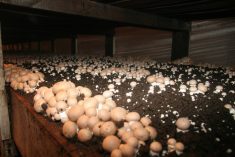Drought may have hindered farmers’ ability to adequately pay workers, but problem is continuation of a long-term trend
What the heck happened to all the farm workers in Manitoba?
That’s what economist Chris Ferris was pondering after seeing statistics showing a gigantic drop in agricultural employment in the province between 2021 and 2022.
“It’s nuts. I just couldn’t believe it,” said Ferris, senior economist with Economic Development Winnipeg.
“This is striking.”
Between January 2021 and September this year, an already large gulf between Manitoba agricultural employment in 2021 and 2022 grew wider. There are now about 25 percent fewer people employed than there were a year ago, a drop to 15,000 from about 20,000.
The slide in agricultural employment appears to have begun in September-October 2021, dropping agricultural jobs beneath a steady range of employment that held from 2015-21.
“It’s a clear break from where we had been,” said Ferris, who has spent much time recently breaking apart the welter of statistics that attempt to gauge the underlying reality of employment.
Why the sudden collapse?
Ferris thinks the 2021 drought is an obvious element, with farms’ finances likely under severe strain, work drying up as the fields and pastures wilted, and farmers only slowly rebuilding their ability to pay for workers as the drought ended and growing conditions normalized.
But the plunge in agricultural employment also coincides with longstanding problems farmers have had in attracting workers. Agricultural employment from 2015 to 2021 would have been thousands higher, undoubtedly, if farmers and other agricultural employers had been able to employ all the workers they wanted. Many agricultural employers today, from hog barns to large grain operations to meat packing plants, are crying out for workers.
How much of this slump is due to pandemic disruptions, which savaged so many sectors of the economy? That’s something else Ferris has analyzed.
Explaining where all the vacancies have come from and trying to figure out where all the workers have gone doesn’t have a simple answer.
“It’s a mix,” said Ferris.
It includes an increase in early retirements in the past year by workers older than 55, well above the long-term average. Immigration was almost shut down for a year and a half, reducing the flow of new people into Manitoba alone by 16,000-20,000 people per year. That flow has only recently returned to something like normal.
Most immigrants don’t work in agriculture, but they take jobs somewhere in the economy, reducing the overall job vacancy rate.
“You shut off your pipeline of foreign workers, that has an effect, even if not direct,” said Ferris.
“It has a knock-on effect on other industries.”
Fewer university students living in cities like Winnipeg also removed those potential workers from the urban labour pool, further increasing the demand from city employers for workers.
As the economy has roared back to life while pandemic restrictions lifted, some employers have aggressively recruited an almost entirely new workforce after being forced to shut down for much of two years. That includes the hotel and entertainment industry, which saw most of its operations suspended and that reduced staffing to skeleton crew levels. People drawn into those jobs won’t be unemployed and looking for jobs on farms and at packing plants.

A cohort of high school-aged potential workers has never worked before, with most part-time jobs being cancelled during the pandemic and with parents discouraging children from working in the midst of a scary disease outbreak. Bringing those workers into employment isn’t a quick process.
And with restaurants and bars now able to operate normally, they’re also working hard to draw in any workers they can. Many are still running reduced hours due to staff shortages.
All in all, it’s a provincial economy still struggling with big gaps between jobs and workers, as well as a time in which legions of older, experienced workers have retired.
As Ferris noted in his Sept. 22 Winnipeg Economic Digest, the drop in the percentage of the population working or looking for work from 66.9 to 65.7 percent adds up to a lot of lost potential workers.
“We would have approximately 14,000 (more) potential workers in August 2022 if the participation rate were held constant at 66.9 percent.”
For agriculture, that’s a problem, as easier to access and easier to do jobs can often be filled before on-farm and other agricultural jobs get considered.
It’s all part of a complex equation that addresses the question of where all the ag employment has gone, but still, looking at the chart of agricultural employment in Manitoba, Ferris is stunned by its starkness.
“What the heck is going on?” was his first thought, but after looking at the situation, there is less mystery and more of a challenge: how can agriculture get back its share of workers and refill its place in the Manitoba economy?
















